
Innovation has broad appeal. Businesses see it as a key to survival, and most individuals enjoy being creative – at work or anywhere. At first it might seem that the discipline called for in the workplace would take all the fun out of being creative. But actually, innovation coupled with Six Sigma discipline and data can be the best way to get results – while having some fun along the way.
While innovation is most visible at the point in a project when solution ideas are generated, the coupling with Six Sigma begins much earlier, at the fuzzy front end. Outlining roadmap connections and sharing some proven tips can help drive creativity Six Sigma projects.
Creativity – Art Form Versus Industrial Strength
A little unlearning may be necessary to get the artistic translation right for the workplace. At one extreme, creativity can be viewed as fanciful inspiration – helping an artist to create a unique work. In this view, the artist cannot be hurried or measured per se since each work is unique and any evaluation would be a matter of taste (Figure 1).
A few software professionals have even been known to hold the “it’s an art” view. They argue that their innovative work is unique and outside the range of things helped by process and discipline. Nonetheless, some of those professionals will admit to considerable frustration as they try to convince others of the merits of their ideas and get their solutions actually implemented. A blend of just enough process and discipline can be found in the Six Sigma roadmap to guide such “artists” to focus even more effectively on what is important, while developing the facts and data required to bring consensus for ideas with the most merit. This can facilitate a move toward the business-driven view of purposeful innovation.
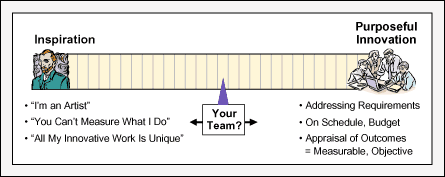
Requirements and Environment Data Can Fuel Innovation
For many, generating and discussing solution ideas is the fun part of innovative exercises. But innovation does not start there. It begins further upstream. A good engineer or designer would not begin working on a solution without having a sense that they really understood the problem context and the full range of explicit and implied needs. Six Sigma supports this engineering good sense with the special attention paid to the planning, data gathering and analysis carried out as voice of the customer work in the Define phase.
To begin an innovation process by generating ideas runs the risk of missing whole aspects of the problem or opportunity. Six Sigma begins not with “What are we going to do?” but with “What do we need to learn?”
Generating a Rich Set of Ideas
A thorough, well-understood set of requirements and measures forms a proper springboard for creativity. By doing this front-end homework, a project team can avoid missing something important while detailing the challenges, constraints and performance factors that are important to address. For members of an innovative team that understands how to use it, this data gets their creative juices going – giving them the whole picture that requires their genius.
There are many ways to generate ideas. A few tried and true principles are:
1. Understand the scope of solutions and ideas that is right for this project. Product development projects can differ widely in the scope of authority and flexibility granted a team for solution development (Figure 2). At one extreme, a team may be charged with identifying and selecting among broad architectural and class-of-solution choices. In other cases, the class of solution may be pretty well fixed, and the creativity may reside more in which features will be included or not. Narrower than that, the choices may come down to innovating on how and how much of each feature will be delivered in a given feature set. It helps a team to know where it is in the “solutions funnel” so the scope and nature of ideas to be generated can match that latitude.
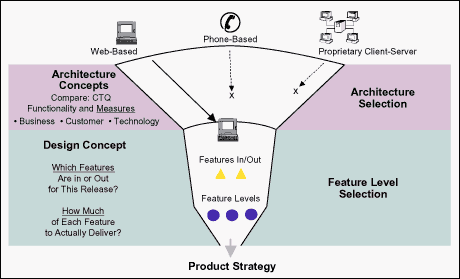
2. Decompose the problem or opportunity. No matter how innovative, a project team cannot create a complete solution by looking at the problem as a whole. Experience shows that it is more effective to break down the problem into bite-sized pieces, to generate ideas that address the pieces, and then to assemble complete solutions from those parts (Figure 3). Six Sigma front-end discipline and detail in the capture and characterization of requirements and measures powerfully prepares a team to be more effective in its innovation at this point. That preparation presents a team with a full picture of “what’s important to address” together with the dynamics that quantify solution success criteria. Innovative idea generation can be stimulated on all the right points.
In subsequent steps, when the ideas are brought together into solution concepts, Six Sigma will drive a team to follow-through effectively, using forecasts of performance on key success measures to guide solution selection and implementation.
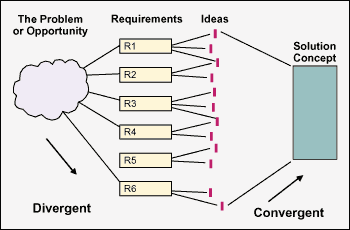
A number of dimensions can effectively guide the decomposition of the problem. Process steps, requirements, measures and elements of the solution architecture all can be used as axes. As a default starting point, the requirements often present a natural hierarchy and basis for breaking down the problem. Each key requirement can be segregated into its own blank page or flip chart – providing room for a range of ideas about how it can be fulfilled. While tracing that case forward, other dimensions like process steps or CTQ measures can be used for decomposition.
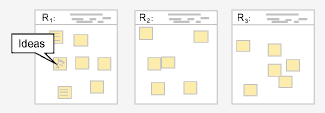
Using a Gallery Walk to Gather Ideas
One of the ways to gather a greater volume and breadth of ideas to address requirements is to set up a gallery walk of requirements. Each requirement panel in the gallery should have space adjacent on which to post ideas which apply to that particular requirement.
Invite as many people as practical to contribute ideas during a number of gallery walk sessions during a period of several days. Of course, people should be welcomed to add new ideas outside of the sessions after they have had time to reflect.
Flowing out ideas at the requirement level avoids constraints and conflicts with other requirements or integration of a coherent system. Participants should be encouraged to wildly dream about the possibilities local to each requirement.
Once past the idea-posting phase, project team members should tour the gallery and complete a three-step process:
- Read each idea and make sure they have a common understanding of what it is.
- Sort the ideas on a fuzzy continuum, from “wild” (interesting but requires bending the laws of physics, etc.) to “practical” (we could use this idea now), with borderline ideas in the middle.
- Take a few minutes to see if some wild or borderline ideas can be made practical with a few modifications.
3. Gather ideas from many perspectives. Grow the team – inviting others with a wide range of views to contribute ideas. The idea pool can be enriched with inputs in each direction – from more senior experts, to people outside the problem, to neophytes who do not already know all the answers.
Tell people to go beyond and outside their most likely, safest answer. Fostering what Edward de Bono, an authority on conceptual thinking, calls “lateral thinking,” invite other less-practical, less-well-thought-out solution paths. Prior solutions and what is known to be safe can form a deep rut in people’s thinking. Contributors need to be coaxed out of that rut by encouraging frivolous, wild and crazy ideas.
Patterns from other problem and solution situations can be used to spark ideas. Analogies are helpful. For a software system that needs to be fault-tolerant, for example, a facilitator may look for fault-tolerant successes in other domains – including in nature. “How can we make it (the solution) be more like a honeybee colony?” might trigger thinking that reaches for original analogies, translating them as fresh ideas into the problem domain at hand. TRIZ (from the Russian acronym related to “theory of inventive problem solving”) is a creative discipline built on the higher-level patterns seen in successful patents across many areas in engineering. Tried and true solution patterns like “nesting” and “prior action” can get team members thinking about if and how these patterns might apply to their current solution challenge.
4. Post-process the ideas. After a good pool of ideas has been captured, it is helpful for a team to review the batch of ideas around each requirement. Team members should ask themselves: Do we understand the spirit of as well as the detail behind the idea? Where does this idea reside on the spectrum from “wild” to “practical”? For ideas deemed wild, is there a variation on the idea that is more practical?
Developing Solution Concepts
The pool of well-understood ideas forms a base from which concepts can be drawn. Ideas enjoyed little constraint as they were gathered against individual requirements. That appropriately opened up the search space. Now the team is ready to pull together one or more solution concepts. A solution concept is a coherent whole, pulling ideas together so that they all play together to address all the requirements.
At this stage it can help to assign sub-teams the responsibility of building alternative solutions, each with a different thrust (Figure 4).
- It often makes sense to build one concept that is “lean and mean” – assembling ideas in a way that minimizes risk and reuses existing resources, etc.
- Another common alternative is an “ultra” concept which argues for more funding and time in order to do some things that would create a new platform, differentiate the company in the marketplace, etc.
- In addition, other concepts with special focuses, such as localizability, environmentally friendly, etc., can be assigned.
Having different alternative solutions, each coherent and complete, with creativity applied to reconciling the technical and business issues sets the stage for a rich set of choices and a best overall solution during the solution selection work to follow.
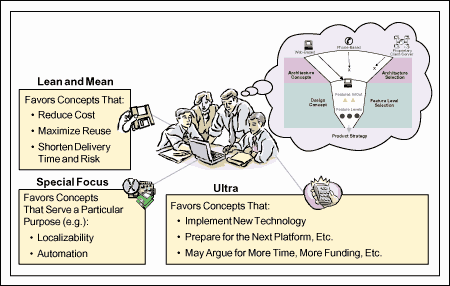
Anticipating Further Innovation Downstream
These steps can help move a team toward the more effective “purposeful innovation” end of the creative spectrum. Yet, creative “artists” can still flourish in this orientation – usually with a lot more pride in the results and a lot less frustration in the process. The “art” game involves starting with a sense of the solution and working to convince others of the merits of one’s ideas. Purposeful innovation begins by helping the creative person discover what is important, and then incubates a wide range of possibilities. That leaves room for plenty of fun. Seeing their ideas actually get implemented while delivering important business results can be a lot more satisfying to people than trying to sell their idea in the business and technical arena.
These key aspects combining innovation and Six Sigma – from project requirements through initial concept development – are just the beginning of the story. Six Sigma also guides the innovation forward through implementation as facts and measures drive concept selection, deployment planning, performance optimization and control.